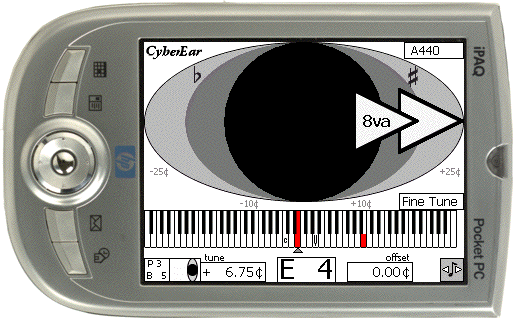
Tuning pianos involves some heavy science and art. In other words, Reyburn Pocket RCT has absolutely no relation to that simple guitar tuner you’ve got in your gig bag. It’s a US$900 powerhouse of visual tuning:
Reyburn Cyber Tuner / Pocket RCT, for PocketPC (Windows Mobile)
This is probably old news if you’re a piano tuner (either this or the Mac/Windows laptop version), but I saw it this weekend while I was staying at my parents’ house and a tuner came over to adjust our Baldwin grand. The tuner was more than happy to show it to me. You can’t tell in this screenshot, but the UI pulses like some sort of alien eye as you near the pitch. The software was able to guess that the piano was a grand of more than six feet just by listening to the harmonic content of the sound (already impressed); it can compensate tuning for the size of the piano. The system uses aural tuning, meaning it looks not only at the fundamental but directly samples and matches partials, which is the way tuners are trained to work.
The tuner was especially pleased by two features: first, that you can keep records of tunings of different pianos, giving the tuner virtual “medical records” of the way a piano has held its tuning over time. (That helps diagnose how the piano itself behaves, and how it responds to the environment.) She was also happy that she could perform extremely accurate overtuning that would anticipate how the tuning would settle over time; because of the enormous sensitivity of pianos, they don’t hold their initial tuning exactly.
I know a couple of musicologist friends who would love playing around with this, particularly the 57 historical tunings from Owen Jorgensen. Now you can finally play the Well-Tempered Clavier on a piano that’s actually well-tempered. For those learning to tune professionally, the software even includes exams, but it sounded as though pros could comfortably use the technology to augment rather than replace their existing craft and experience.
We have at least a couple of pro tuners reading CDM, so I’d love to hear what you think of this. Maybe some of you think this new-fangled tech is useless; I don’t know.
Updated: Via comments, Veritune is a formidable competitor to this product. The concept is the same, but Veritune has a real-time spectral display, multiple simultaneous partials, far more notes measured (76 vs. 6), note switching for all notes, no required measurement step, and other features. It’s also available in an integrated, rugged hardware unit as well as for your existing PocketPC, and Veritune claims it’s easier to use. Anyone who’s used one or the other, let us know what you think. Thanks to Carl Lumma, formerly of Keyboard Magazine.